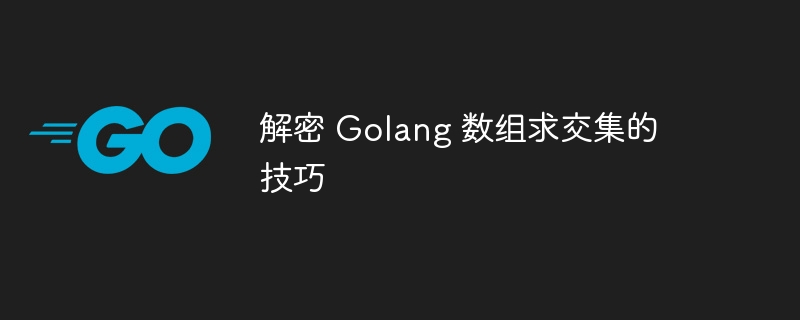Home >Backend Development >Golang >Tips for decrypting Golang array intersection
Tips for decrypting Golang array intersection
- 王林Original
- 2024-04-03 17:39:011522browse
In Go language, the methods to find the intersection of arrays are: use the built-in function Intersect, which is suitable for sorted arrays. Use map, suitable for large arrays or arrays with few elements. Custom sorting and binary search for very large arrays. Which method to choose depends on the size of the array and the distribution of elements.

Decrypt the techniques for finding the intersection of Go language arrays
In the Go language, an array is an ordered collection that stores elements of the same type. . Performing an intersection operation on arrays can obtain elements that exist simultaneously in two or more arrays. The following introduces several practical techniques for finding intersections in different scenarios.
Built-in functionsIntersect
Go language provides the Intersect function in the sort package, The intersection of two sorted arrays can be found directly. This function receives two sorted arrays as arguments and returns a new array containing the intersection elements.
package main
import (
"fmt"
"sort"
)
func main() {
arr1 := []int{1, 3, 5, 7, 9}
arr2 := []int{2, 4, 6, 8, 9}
sort.Ints(arr1)
sort.Ints(arr2)
res := sort.Intersect(arr1, arr2)
fmt.Println(res) // []9
}For smaller arrays, the Intersect function is an efficient and concise solution.
Use map
For large arrays or arrays with few elements, it is also effective to use map to find the intersection. Methods. By using an array as a key to a map, you can quickly check whether an element in another array is also in the map.
package main
import "fmt"
func main() {
arr1 := []int{1, 3, 5, 7, 9}
arr2 := []int{2, 4, 6, 8, 9}
m := make(map[int]bool)
for _, v := range arr1 {
m[v] = true
}
var res []int
for _, v := range arr2 {
if m[v] {
res = append(res, v)
}
}
fmt.Println(res) // []9
}Custom sorting and binary search
For very large arrays, using custom sorting and binary search algorithms for intersection can achieve better performance. First sort both arrays, then iterate through one of the arrays and perform a binary search on the other to find matching elements.
package main
import (
"fmt"
"sort"
)
func main() {
arr1 := []int{1, 3, 5, 7, 9, 11, 13, 15}
arr2 := []int{2, 4, 6, 8, 9, 10, 12, 14, 16}
sort.Ints(arr1)
sort.Ints(arr2)
res := intersection(arr1, arr2)
fmt.Println(res) // []9
}
func intersection(a, b []int) []int {
var res []int
for _, v := range a {
idx := sort.SearchInts(b, v)
if idx >= 0 && b[idx] == v {
res = append(res, v)
}
}
return res
}Based on the array size and element distribution, choosing the most appropriate intersection technique can optimize code performance.
The above is the detailed content of Tips for decrypting Golang array intersection. For more information, please follow other related articles on the PHP Chinese website!

